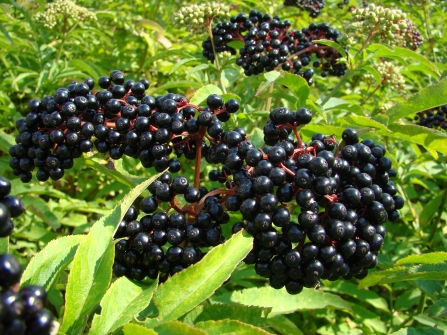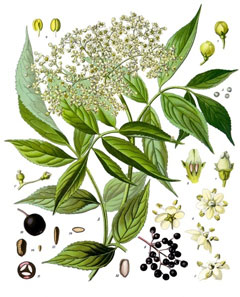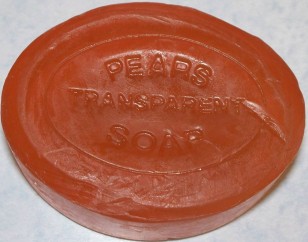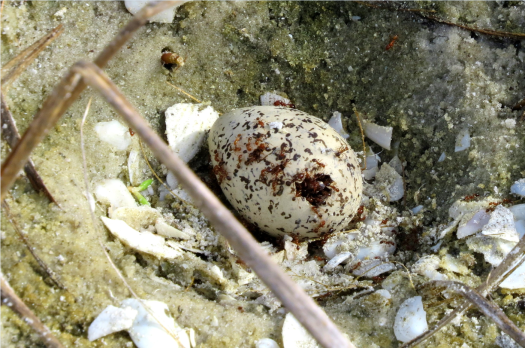Tags

In 1656 William Coles documented the belief that gathering the leaves of elder on the last day of April and attaching them to one’s doors and windows would, “disappoint the charmes of Witches”. Elder bushes were an integral part of gardens through the 18th century, and why not? How could one overlook the tasty flowers and berries prepared in a myriad of ways with the added benefit of warding off witches?
Elder plays a part in the early folklore of several countries. Russians used to believe the spirit of the elder had great compassion for human beings and drove away evil spirits from them. The Danes refused to make furniture from elder wood believing that doing so brought ill luck. “If a cradle is made of the wood, the Elder Mother will come and pull the child out of it”.
Bushes can be dug from the wild, propagated by rooting in water or planting in soil, or bought from a nursery. If rooting 6 inch cuttings in water plant them in small pots once roots are established. Place the pots in a shaded location and keep watered until the following spring then plant in the home landscape. If starting in soil, place the pot with the cutting inside a plastic bag so that a humid environment is simulated until the cuttings are rooted (keep out of direct sunlight), and proceed as above. While the bushes are self-pollinating, planting more than one variety is said to produce bigger berries.
Elderberries are small and it would be very time consuming to pick them individually, therefore, when harvesting the recommended method was (and is) to cut the heads and let them drop into a basket. One can then pick off the berries, or wash the heads and drop them into boiling liquid removing and discarding the remaining stems. A quicker way to remove the berries from the stems is to cover a bowl or bucket with half inch wire mesh and just pass the berry bunches back and forth across it. The berries will fall through the holes into the container.
All parts of the bushes have been used for one thing or another. “The pith of the tree has wonderful powers, for, if cut in round, flat shapes, and dipped in oil, lighted, and then put to float in a glass of water, its light on Christmas Eve will reveal to the owner all the witches and sorcerers in the neighbourhood. While this sounds ridiculous today, the Salem witch trials are proof that such things were once deadly serious.

Buds were pickled with pepper, mace, and lemon peel, elder tops (young shoots) were pickled, flowers were used to flavor vinegar or make drinks, the flowers were dipped in batter and fried to make fritters, sprays of flowers were put into sugar to impart a pleasant flavor, the berries were used to make wine, juice, pies, jam and jelly, tea can be made from the leaves, and the berries were used to make ink and to dye various items including champagne and leather.
Why aren’t we familiar with using these berries today? Because, like many other plants, the lowly wild berry came to be considered inferior when tame berries were cultivated to produce larger and juicier fruit with less labor. “It is strange that when there is a scarcity of fruit, as there was last year, people will lament the lack of fruit, when behold the fence corners are filled with these valuable bushes, bending down and overloaded with ripe delicious fruit that all goes to waste. You need never be at a loss for fruit to make pies, for it grows spontaneously…Remember other fruit is liable to fail while this is a never-failing fruit”. – “The Ohio Cultivator”. 1853.
Below are some historic elderberry recipes which may tempt you, but you may also want to try adding the berries to muffin, fritter, or pancake batter, mixing elderberry syrup with iced soda water for a refreshing drink, using the juice to make frozen popsicles or ice cream, etc.
ELDERBERRY ICE CREAM [modern]. This is similar to black raspberry ice cream that is popular in Pennsylvania.
2 cups elderberries (no stems); 1 cup water; sugar as desired; 2 cups heavy cream or half and half; 1 ½ cups milk; 5 egg yolks. The syrup can be made ahead of time and refrigerated.
Combine the berries and water, bring to a boil and simmer until the berries begin bursting. Add sugar half cup at a time until as sweet as you like. Let the mixture cool slightly, then run it through a food mill or sieve. Discard the solids. Refrigerate until ready to use.
To make the ice cream: Put the cream and milk into a heavy pan and slowly heat it, stirring so that it doesn’t scorch. Add the elderberry syrup a half cup at a time until the flavor is as deep as you wish. Bring the mixture to steaming but not simmering or boiling.
Beat the egg yolks in a small bowl. Add a few spoonfuls of the cream mixture, whisking all the time, to the egg yolks. Continue until the egg yolks are brought up to temperature without cooking and whisk all together. Chill the mixture. When cold put into an ice cream maker and proceed as for any basic ice cream. The ice cream can be served as is, or made into popsicles.
ELDERBERRY PIE. “Table Talk”. Aug. 1903.
Line a pie dish with paste, upon which sprinkle a scant tablespoonful of flour; to this add a half cupful of sugar and a half teaspoonful each of cloves and cinnamon, rubbing all together evenly. Upon this pour the berries, a pint more or less according to the size of your pie dish; pour over another half cupful of sugar, dot generously with butter, adding last one large tablespoonful of good vinegar. Apply top crust quickly and bake.
ELDERBERRY PIE. “Good Housekeeping”. 1891.
For a large pie, allow three cupfuls of berries, two tablespoonfuls of lemon juice or vinegar, two tablespoonfuls of flour, three-fourths cupfuls of sugar, and spices to taste. Bake in one crust with a latticework top.
ELDERBERRY SHRUB. Pour one pint of weak vinegar over one quart of elderberries; let them stand for twenty-four hours. Strain, and pour the juice over a second quart of berries. Let them stand for twenty-four hours, strain again, add one cupful of sugar to each cupful of juice, boil it up, and can or bottle if wanted for future use. [To use, combine with ice water and drink].
ELDERBERRY CATCHUP.
Elderberry catchup is excellent with game or cold meats. Boil one quart of the berries with two cupfuls of vinegar and one tablespoonful of pickling spices tied in a muslin bag, for twenty minutes. Put through a press or sieve that will retain the seeds, add two cupfuls of brown sugar, and simmer for ten minutes before sealing.
ELDERBERRIES DRIED. Berry, Mrs. “Fruit Recipes”.
Sun-dry the berries as for strawberries. In some parts of Europe peasants use these in soups through the winter.
ELDERBERRY DUMPLINGS. “The Ohio Cultivator”.
Make the crust as usual and put in the berries as you would other fruit. Boil them fast till the crust is done, then take them up and eat with a dip of white sugar and sour cream, and you will confess they are delicious.
ELDERBERRY SYRUP. “The Every-Day Cook-Book”. 1889.
Take elderberries perfectly ripe, wash and strain them, put a pint of molasses to a pint of the juice, boil it twenty minutes, stirring constantly, when cold add to each quart a pint of French brandy; bottle and cork it tight. It is an excellent remedy for a cough.
ELDER TOPS, TO PICKLE. “Cassell’s Dictionary of Cookery”.
About six inches of the tops of young elder sprouts, if cut at the right time—in the middle of April—will make a good pickle. The sprouts should be first blanched in boiling water, then pickled in vinegar, adding salt and white pepper. [Month when these shoots are at their prime will vary with locale].
Blissful Meals yall, cultivated or foraged, there are good things growing out there. – Thehistoricfoodie aka Vickie Brady. Copyright©
See: Rohde, Eleanour, “A Garden of Herbs”, 1922. Berry, Mrs. “Fruit Recipes”. 1903.














You must be logged in to post a comment.